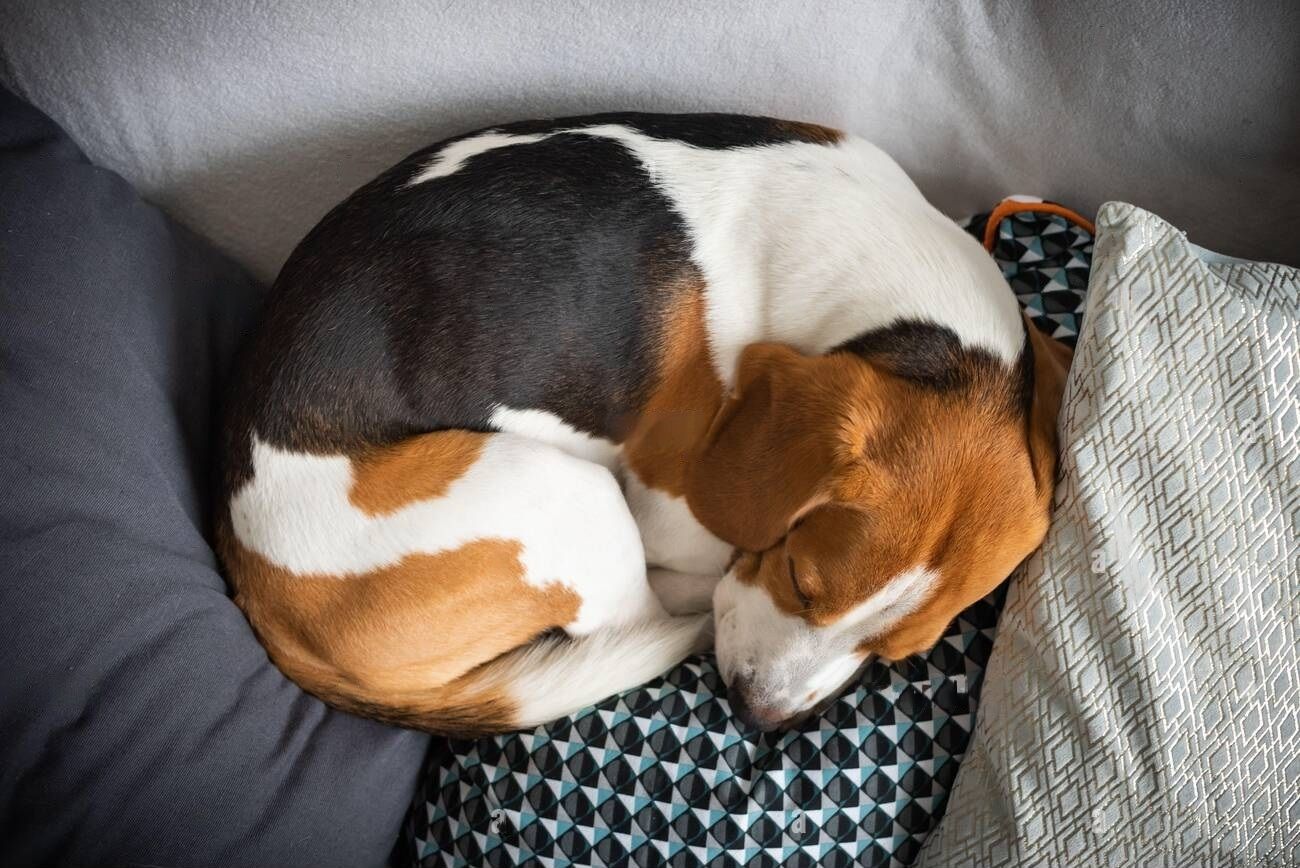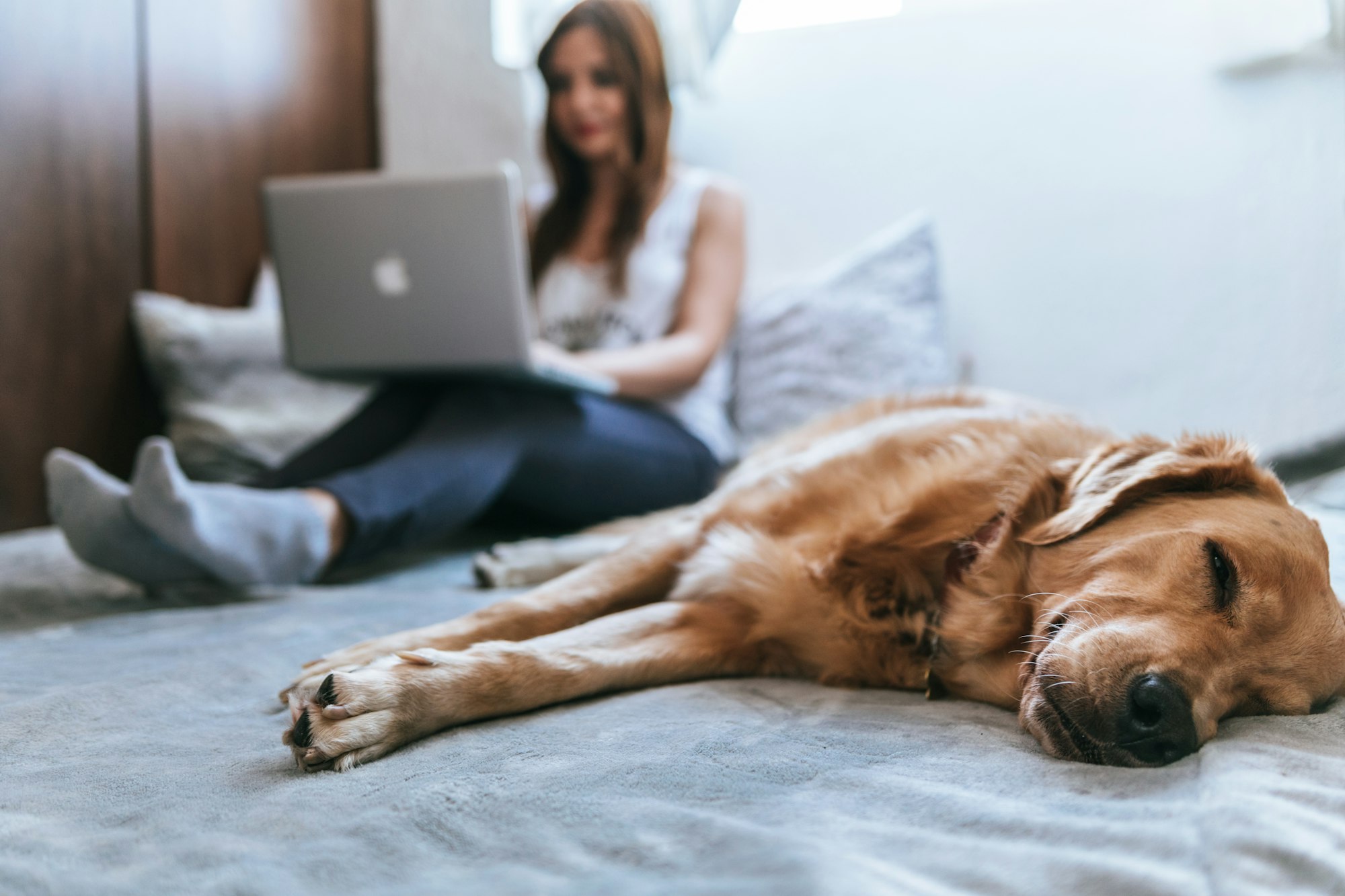Dogs are known for their diverse and complex behaviors, which often serve as a means of communication with humans and other animals. One such behavior is the curling-up posture that dogs adapt in various situations. While it may seem like just another comfortable sleeping position, there is much more to a dog's curled-up body language than meets the eye.
Understanding the significance of canine body language can help us build stronger relationships with our pets and ensure their overall well-being. This article will explore what it means when a dog curls up.
Discuss its evolutionary and biological origins, examine its health implications, and provide tips on promoting positive curling-up behavior in your furry friend. By decoding this seemingly simple behavior, you can gain deeper insights into your dog's emotional state and improve your bond with them.
What is The Dog's Curl-Up Behavior

The curl-up behavior of dogs involves the animal forming a compact, protective posture and is believed to have evolved as a survival mechanism. This position is commonly observed when dogs take naps or go to sleep.
When curled up, dogs tuck their nose under their tail and legs close to their body, which helps them conserve body heat. This sleeping position also allows them to protect vital organs while they rest.
The influence of the dog's breed and personality on curling up can vary widely. Some breeds are more prone to this behavior due to their ancestry. For example, smaller breeds like Chihuahuas and Pomeranians may feel more vulnerable in certain situations, so they tend to curl up more often than other breeds.
On the other hand, some individual dogs may curl up simply because it's comfortable for them or because they prefer it over other sleep positions. Veterinary professionals and dog owners alike need to be aware of these behaviors as understanding canine body language can help promote better communication between humans and our furry companions.
What does it mean when a dog curls up?

When a canine assumes a compact position with its limbs huddled under its body, it conveys a sense of security and comfort. This behavior is commonly observed when dogs sleep or rest when they curl up in a ball.
Dogs like to sleep curled up because it helps them feel safe and protected, much like how humans find comfort in hugging themselves. The curled-up position is one of the most common dog sleeping positions.
When a dog curls up in this way, it means that they feel secure and cozy enough to let its guard down while still being alert to any potential danger. This behavior has evolved from dogs needing to protect themselves from predators while they sleep.
Therefore, if your furry friend chooses to sleep curled up next to you, take pride in knowing that you have earned their trust and affection.
Why is my dog curled up like a donut?
Assuming a donut shape, dogs often curl up into a ball by tucking their head and tails under their body. This sleeping position for dogs is comfortable and serves as a way to conserve body heat and feel more secure. By tucking their nose under their tail, they can create a warm cocoon-like environment that makes them feel safe and protected.

Dogs are naturally social animals who thrive on companionship and human interaction, so providing them with a sense of security when they sleep is essential. When curled up in this position, dogs are likely in a deep sleep, allowing them to rest physically and mentally.
Pet owners must understand the meaning behind this sleeping posture as it can indicate whether or not the dog feels safe and comfortable in its environment.
Do dogs curl up when they don't feel good?
One possible indicator of a dog not feeling well is a normal sleeping posture change. Dogs who sleep curled up may try to conserve body heat, but this position can also indicate that a dog feels safe and secure.
However, if your dog suddenly starts sleeping in this position more often, it could be a sign that they are feeling stressed or anxious.
It's important to pay attention to your dog's sleeping habits and the positions they take while asleep. Some dogs who need extra comfort or security may prefer to sleep curled up, while others who feel confident and relaxed may stretch out in different positions.
Understanding your dog's body language can help you identify when something might be off with their health or emotions.
What are the warning signs your dog is crying for help?
Identifying warning signs that your furry companion may be in distress is crucial to ensure their well-being. One of the most telling indicators of a potential problem is when your dog curls up and remains sleeping in this position for long periods.
While it may be tempting to assume that this behavior indicates that your dog feels safe and relaxed, it can also signify underlying health issues or discomfort.
To prevent any potential problems, watch out for these warning signs that your dog may be crying for help:
- Lack of appetite
- Unusual lethargy or listlessness
- Excessive panting or breathing difficulties
- Vomiting or diarrhea
- Aggressive behavior
If you notice any combination of these symptoms and your dog's curled-up sleeping position, it may be time to consult a veterinarian. You can help keep your canine companion healthy and happy by staying vigilant and recognizing these warning signs.
Health Implications of Curling Up
Determining whether a dog's curled-up sleeping position is normal or indicates a health issue can be challenging for pet owners. Still, according to recent studies, up to 30% of dogs may experience joint or muscle pain that causes them to curl up more frequently.
While some dogs prefer the comfort and security of being in a tight ball, others may curl up due to underlying medical conditions such as arthritis, hip dysplasia, or spinal issues.
To determine if your dog's curled-up position is related to their health, it is important to observe their behavior during waking hours and look for other signs of discomfort such as limping or difficulty standing up or walking stairs.
Common health problems that might cause a dog to curl up more frequently include osteoarthritis which is characterized by inflammation and degeneration of joints.
Other possible causes include muscle strains, ligament sprains or tears, herniated discs in the spine, and even neurological disorders like intervertebral disc disease (IVDD).
If you notice that your dog's curled-up position is accompanied by any unusual behaviors such as whining when getting up from lying down or reluctance to engage in physical activities they normally enjoy like playing fetch or going for walks; it could indicate something more serious.
In this case, seeking veterinary care is essential before the condition worsens and leads to permanent damage.
Impact of Sleeping Positions on a Dog's Health
Understanding the impact of different sleeping positions on a dog's health is crucial for pet owners to promote their overall well-being.
One of dogs' most common sleeping positions is curling up, which can provide several benefits for their physical health. When dogs curl up, they conserve body heat and protect vital organs, which helps them stay warm and safe during sleep. Additionally, dogs that curl up may feel more secure and comfortable in this position, reducing stress levels and promoting better sleep quality.
While curling up is a natural and healthy sleeping position for many dogs, other common sleeping positions could indicate underlying health issues. For instance, if a dog sleeps on their back with their legs in the air or sprawled out to the sides.
It could indicate discomfort or pain in their joints or muscles. Similarly, if a dog consistently sleeps with its head raised or propped up against an object, it may struggle to breathe properly due to respiratory issues.
By understanding these different canine body language signals associated with various sleeping positions, pet owners can monitor their pets' health more closely and seek veterinary medical attention as needed to ensure optimal overall wellness.
To promote healthy behaviors while sleeping, pet owners should ensure that their dog's sleeping environment is clean, comfortable, and free of distractions such as loud noises or bright lights. They should also select appropriate bedding materials based on their pet's individual needs. Some dogs prefer softer surfaces like blankets or pillows, while others prefer firmer surfaces such as mats or crates.
Overall, by paying close attention to their pet's behavior when curled up or asleep in general – including any changes in routine patterns – pet owners can help keep their furry friends healthy and happy for years to come.

Promoting Comfort in Your Dog's Environment
The previous subtopic discussed the benefits of a dog curling up to sleep and how different sleeping positions can indicate certain behaviors. Now, let's dive into ways that we as pet owners can promote comfort in our dog's environment and encourage positive curling-up behavior.
Firstly, providing a comfortable space for your furry friend to rest and relax is crucial. This means investing in an ideal dog bed that suits their size and sleeping habits. A good bed should support their joints, be easy to clean, and have enough padding for them to feel cozy. Additionally, placing the bed in a quiet area away from high-traffic rooms or loud noises will help your pup feel safe and secure.
To further promote positive behavior, here are some tips on how you can encourage your pup to curl up comfortably:
- Provide soft blankets or pillows for added warmth
- Use calming scents such as lavender or chamomile
- Incorporate soothing music or white noise during nap time
- Reward with treats when they use their designated bed space
Frequently Asked Questions
What does it mean when a dog sleeps in different positions besides curling up?
One may think that a dog's sleeping position holds great significance, but research suggests otherwise. While curled up is the most common position, dogs also sleep on their sides or stomachs. The position may reflect comfort rather than emotion.
Can a dog's breed affect how often they curl up?
No conclusive evidence suggests that a dog's breed affects how often they curl up. Further research may reveal correlations, but for now, it remains uncertain.
Are there any benefits to a dog curling up besides comfort?
Surprisingly, dogs curled up for comfort also benefit from improved blood circulation and joint health. This position also allows them to conserve body heat and protect vital organs while resting.
What common health problems can cause a dog to curl up frequently?
Frequent curling up in dogs may indicate underlying health issues such as pain, arthritis, or digestive problems. A thorough medical examination by a veterinarian is recommended to identify and treat any potential health concerns.
How can a dog owner encourage positive curling-up behavior in their pet?
Encouraging positive curling-up behavior in dogs involves providing a comfortable and safe environment. This includes cozy bedding, adequate exercise, and socialization. Positive reinforcement through treats or praise can also healthily reinforce this behavior.
Conclusion
In conclusion, the curled-up position of dogs is a fascinating behavior with both evolutionary and biological roots. It can be influenced by breed and personality traits, but it's mostly a sign of comfort and relaxation. However, it's important to recognize when this behavior may indicate underlying health problems.
Owners should also consider their dog's sleeping environment to promote healthy behaviors. Ironically, while dogs curl up in a seemingly harmless manner, humans often neglect their pet's need for comfort and safety. Our owners are responsible for providing a comfortable space that encourages positive curling-up behavior.
By understanding the significance behind this behavior, we can better care for our furry friends and ensure they lead happy and healthy lives.






